Notes on Airports
Daniel Barbiero
October 2017
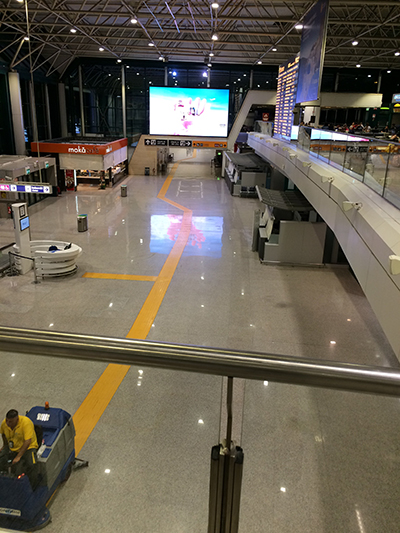
SOMEWHERE IN BETWEEN (An Image of Finitude)
The air terminal is a place that feels like a kind of limbo—a place where we’re neither here nor there. It’s a place situated in the present—in our present, as travelers—that we only grasp through the future; this future consists in the place we’re trying to get to. To this extent it is a kind of placeholder—an empty cipher inserted in between two given values. Consequently, our relationship to it takes on a case peculiar to it.
As a general matter, our relationship to a place is constituted by the possibilities we can find in it and conversely by the way that it limits those possibilities and helps to determine that same relationship. A place like an airport is the kind of place that French anthropologist Marc Augé called a non-place– a site of transient commercial activity in which those passing through are engaged in a short-term transactional relationship—or a variety of what I have elsewhere, borrowing a term from Italian philosopher Franco Rella, characterized as an atopia, or a place in which one feels dis-placed.
Transience is the key here. The possibilities we find in an atopia like an air terminal are limited by the transience of our relationship to it. A transient relationship is an uncommitted one, and one that will tend toward the instrumental. The relationship is only good for as long as it supplies some means toward an end that transcends it; it is an infinitely finite thing.
Finitude is the lurking hallmark of transience. Our time in an air terminal and places like it is limited, marked by this transience—a peculiar temporary state whose finitude seems to parody the finitude of a living being. But it’s a finitude that can seem to stretch out when time becomes empty and consequently seems to lose value—it’s time killed, time wasted. Here specifically, it’s time lost to waiting. In fact one of the forms of dis-placement the airport has to offer is played out in the concrete, temporal dimension embodied in the guise of waiting. Waiting to leave, or conversely, waiting for someone to arrive.
The elongation of time we experience when we’re just marking time may obscure the essentially temporary nature of our being here—waiting in between flights may seem to last forever—but the fundamental relationship we have to this place is bounded on either side by a timetable carving time at artificial joints, breaking it up into discrete and finite units and putting it onto a schedule. A schedule is a schedule, even if the flight is late.
As a place that’s neither (our) here nor there, the airport is an inert given that is there to be transcended, a blank means to be used and left behind once we’re on our way elsewhere. Because in the end, what we’re looking for in the airport isn’t really to be found there. It’s elsewhere, in the destination we eventually hope to reach. Thus the airport is a place that points away from itself to another place. But in our efforts to reach that other place we necessarily pass through this place in which we are temporarily placed and dis-placed.
Our time in the airport belongs to a radically finite present, but it holds out the promise of a future—somewhere else.
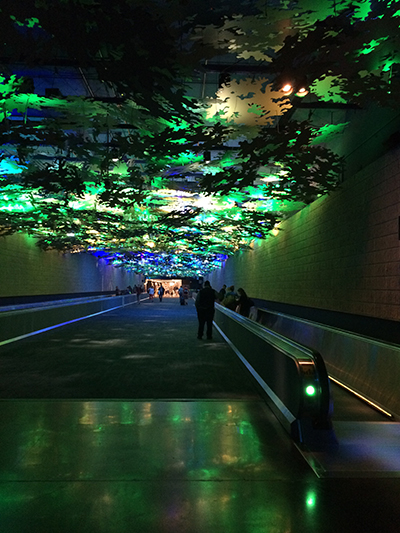
ANXIETY & ANXIOUSNESS (Under Imaginary Trees)
A common way of experiencing an airport is through the filter of anxiety. Boredom too, but perhaps with an anxious edge.
In a general sense, anxiety attaches simply to the fact that one must act, one must make choices and has no choice but to project into a future. Anxiety in a specific sense—perhaps better termed anxiousness–attaches to the concrete possibilities that one sees in a given set of circumstances, and in the particular types of failure that might arise within those circumstances. And thus we experience anxiousness over the possibility of being late and missing a connection, or of having forgotten something—anything from a trivial item that can easily be picked up at the destination or at a store inside the terminal, or something crucial, like a passport or wallet; the disorientation of being in a new place or one in which the language and customs are opaque; or simply the natural apprehensiveness over being in the unnatural position of hurtling miles above the earth’s surface in a thin-skinned aluminum tube.
One possible if subtle source of air travel anxiety may lie in the architecture of the airport. Particularly in the more modern buildings, the architecture is deliberately bland and antiseptic, with often self-consciously futuristic lines and smooth, unembellished surfaces of metal and glass. These hard surfaces deflect any sense of comfort even as they seem to encourage us to move on.
Even so, it would seem that at least some environmental concessions have to be made to alleviate the traveler’s potentially omni-present, unsettled state of mind. Brian Eno’s Music for Airports famously was one such attempt; the music was intended to dispel anxiety (being composed, as it was, by someone himself subject to air travel anxiety). Other attempts to soothe anxiety may take the form of restrained lighting or the abstract simulacrum of an outdoor scene—an imaginary canopy of stylized leaves spreading out over the moving walkway.
Frequent travelers may become habituated to airports and flying, but it seems reasonable to think that running beneath a routine attitude toward air travel there still is an atavistic current of anxiety.
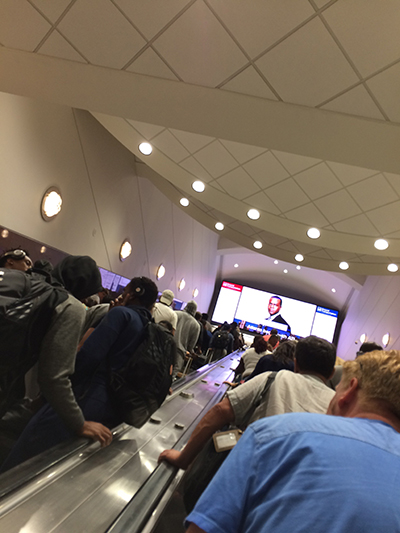
THE INTERCHANGEABLE TRAVELER (Up an Escalator)
By definition, public space holds the possibility of encounter. Its layout, its openness to use, its status as a common instrumentality—as something made available to virtually anyone—all signify the possibility of its being the locus of activity by multiple people acting independently or in coordination. It is, in other words, a site of coexistence.
As the Italian philosopher Nicola Abbagnano suggested, coexistence is the essential existential situation we find ourselves in. We are thrown together into a world not of our choosing and that world inevitably includes other people; coexistence simply arises from this fact; it simply is this fact. The world isn’t of our choosing and neither, necessarily, is the fact of our being together. But it is a determining fact, a limitation to be accepted. Coexistence inheres in the possible concrete relations one can have with others: as coexistents, we necessarily take up attitudes toward our fellow coexistents—as collaborators, competitors, friends, family, onlookers, antagonists, and so on.
Just as there are many modes of coexistence generally, there are many modes of encounter specific to a public space. Frequently, coexistence there takes the form of an unorganized set of individuals juxtaposed and related only because they happen to be in the same general space at the same time. But even strangers occupying a space for a short time can form a cohesive group related through a common project. Take for example, the people in an air terminal collected around any given gate, waiting for their flight to board. This collection of otherwise perhaps incommensurable individuals represents a coalition of temporarily coinciding goals grounded in the concrete choices that put them here to begin with; this temporary coincidence creates an artificial synthesis that binds together these unrelated individuals into a unity, if only for the duration of the wait, and beyond that, of the flight.
In a place like an airport, the attitude we take up toward the others immediately surrounding us is complicated by the paradoxical nature of the kinds of identities we are likely to attach to them—as they are likely to do to us as well. The transactional nature of the relationships natural to a place like this will tend to be impersonal. Fundamental to this relationship is the transience and fungibility of those involved in it: The relationship is temporary, sometimes exceedingly so, and the identities of those engaged are as a result of no lasting consequence—individuals are fungible. This combination of transience—of rootlessness and dis-placement—and fungibility constitutes a variety of anonymity which solicits very little sense of solidarity from us as fellow, equally anonymous, individuals.
A traveler passing through an airport terminal is, from one point of view, like any other traveler passing through the terminal. All have in common that they are there only to get somewhere else; the possibilities offered to one are in that sense limited to what can be offered to anyone else. The individual traveler’s project, which is to go somewhere specific for some specific purpose, is from this perspective reduced to a generic project of travel.
But paradoxically, at the same time that they are interchangeable, these generic projects when seen at a more fundamental level are incommensurable. For ultimately each one comes down to a set of possibilities specific to each and unique to each, precipitated out of a situation that represents the unity of a given past projecting itself into a future that each has uniquely to be. As travelers they may be interchangeable, but travel is just one moment in a larger movement toward being that no one can be for anyone else. The incommensurability of these juxtaposed individual actors pursing individual goals is likely to produce a mutual relationship of indifference or, in some cases, antagonism. The latter is always a possibility although the former would seem to be more common, whether as a matter of etiquette or genuine lack of interest.
The stranger seen on an escalator is seen in passing—literally, as we cross paths as she is on her way up and we on our way down. Do we see someone we see in passing as individuated and singular, as a unique person trying to realize the concrete possibilities available at hand? Or as just another figure more or less opaque to us as it goes from one place to another?
The stranger’s existence as a fellow intentional agent, with goals and concerns of his or her own which we see embodied in his or her motions, may strike us as a set of gestures unifying a field of action or meaning that is not ours. It “isn’t for me” or is “none of my business.” It is a matter of indifference to me (an indifference that may be assumed to be mutual). And so we pass each other in opposite directions.
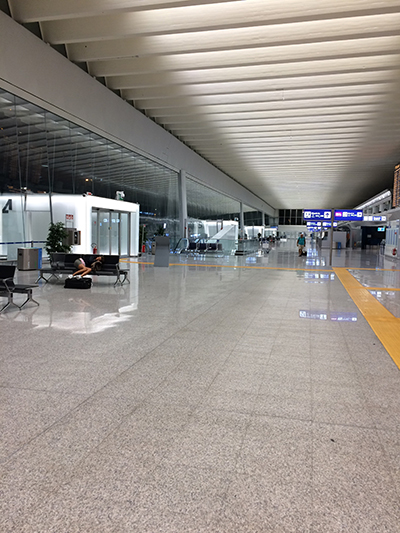
WHEN THE PUBLIC BECOMES PRIVATE (Asleep in an Airport)
It isn’t uncommon to encounter someone on layover sleeping in an airport or train station–it’s just an expedient way of meeting a private need in a public place. What’s striking about it is the incongruity of the situation. The sleeper withdraws into the irreducibly private world of sleep—doing so all the while in a public space. This inevitably brings to mind the Cynic philosopher Diogenes of Sinope, who was notorious for living in a tub or empty wine cask in Athens’ Metroön. Diogenes’ living in public reversed the ordinary relationship between the public and the private by turning private life into public display. The person asleep in the airport terminal seemingly reverses Diogenes’ reversal by turning the public space into a private space. But it isn’t really a private space, only the facsimile of one.
To the extent that a public space gives the appearance of privacy, it is because of the indifference of those who don’t notice others or the tact of those who pretend not to notice. There is a certain etiquette involved in being in a public space, a fiction based on a silent contract binding those passing through the space. To notice would be to break the contract, to expose the fiction.
But as with any contract, this one binds the other party as well. This is at least in part a recognition that things ordinarily done in private are likely to take on a different meaning when done in public. For example, the public airing of confidences normally shared in private are likely to be taken as an affront or an imposition, as Diogenes’ living outdoors was taken to be. In that case the indifference of the onlooker may change to puzzlement, disgust, or any of a series of reactions in response to how intimate, and therefore un-public, the conversations or acts in question are. I can recall a subway ride in which a woman on a cellphone was describing in great detail a medical operation she’d recently had. Maintaining the fiction of ignorance and indifference was virtually impossible—there was too much exposure. We were exposed to too much about the speaker’s condition, as she exposed too much about herself.
Someone who tries to sleep in an air terminal is also exposed, and one wonders how deep a sleep can be had in conditions so open to view. Like the airport itself, sleep here is an expedient to be made the most of for as long as it must.
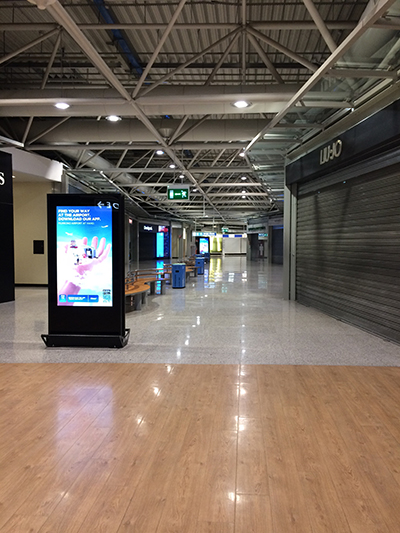
THE EMPTY AIRPORT (An Asymmetry of Meaning)
Empty, the airport is like a tool put down and out of use. Abandoned and inert, a mute in-itself when there is no one here to use it for its intended purpose. (The maintenance workers and other personnel who work, largely unnoticed, to keep the systems running have their own purposes and pursue their own projects in working there, of course, but these purposes are subsidiary to the place’s main purpose.)
The airport is constituted as a place with a specific function—with a character of equipment—by the needs of the people who use it. It is this need, which each one posits through the desired end of ending up at their chosen destination, that constitutes the airport for what it is—animates it from without.
When I grasp a place such as this as equipment I infuse it with meaning that derives from a set of possibilities that are my possibilities. It has a role to play in relation to my own projects and preoccupations. To that extent, meaning comes to it from outside, from the goals and desires of people extrinsic to it as they transit through. It is just an instrument and as such is meaningful only for as long as it in use.
But by virtue of its usefulness, this instrument means more to us than we to it. As we’ve seen, any of us who have occasion to use it are fungible, perfectly interchangeable and standing in the same relationship to it as anyone else. We’re just anonymous users whose specific purposes are none of its concern and of no interest. To us, on the other hand, it carries a meaning and consequent emotional charge associated with whatever project we needed it for—a trip to visit an ill relative, passage to a holiday destination or business meeting. Whatever emotional state we are in when we pass through an airport or make a stop along the highway imprints itself by way of association. We remember the airport or highway rest stop, to the extent that we do remember it, within that emotional framework. Revisiting such a place can serve as the equivalent of the madeleine dipped in tea: A prompt to recollect and mentally recreate an emotionally-charged world we once lived through by associatively bringing back to life the mood that had enveloped it. (And it’s odd that one can have strong feelings associated with a place as deliberately bland as an airport or highway rest stop. It all depends on where we’re going at the time, and why.)
And that is the asymmetry of meaning here: Our meaning is its indifference. An airport has meaning only in spite of itself.
[Shortly before the release of our collaborative work Non-places, Cristiano Bocci came over to the US for a brief visit. Appropriately enough, while in transit he documented his passage through the Rome and Paris airports—consummate non-places. His images inspired these notes.]
Images of Paris and Rome airports by Cristiano Bocci
Read on Arteidolia
Atopia: Soundings from Non-places by Daniel Barbiero
If Utopia is an ideal place that doesn’t exist—a perfect place that is nowhere except in the imagination—Atopia is a place that does exist, albeit as a non-place. A nowhere that is here.
